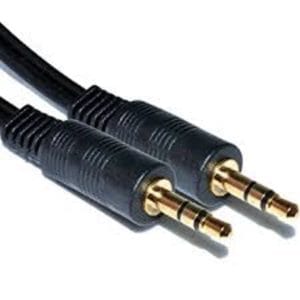Cables & Adapters at O2 Computers

Keep all of your users and devices communicating properly with cables and cable adapters built to deliver reliable, high-quality connectivity. O2 Computers carries a wide array of cables available in every type, length, color, and standard imaginable. We also offer all of the cable accessories you need—including Digital and Analog Converters like HDMI to VGA, VGA to DVI, DVI to HDMI, RCA, Audio Converters, specialty connectors, Type C Connectors and many more—to make every installation manageable and organized.
From network cables to power cords, you’ll find everything you need to keep your devices online and your users connected. You’re getting the best quality cables and cable adapters available.
Need a specific type of cable or connector? Our team at O2 Computers can help you track down the right product for your needs. If you’ve set your sights on a bigger project, such as upgrading or expanding your network, we can help you optimize your infrastructure with a Network Assessment. From identifying hardware that needs to be upgraded to pinpointing performance bottlenecks, we can help ensure that your users enjoy the connectivity to respond to business needs quickly and effectively. Whether you need a single cable or help designing and deploying infrastructure for a new data center, we can connect you with the right products and services to get the job done.
We stock all Cables related to Computers, Networking and Cell Phones.
Types of Cables In Stock
- VGA Cable
Also known as D-sub cable, analog video cable

Connect one end to: computer monitor, television (PC input port)
Connect other end to: VGA port on computer (see image below)

- DVI Cable

Connect one end to: computer monitor
Connect other end to: DVI port on computer (see image below)

However there are 2 types of DVI, DVI-I and DVI-D.
DVI-D does not have the extra pins around the long pin, this is also a pure digital signal over DVI-I.
- HDMI Cable

Connect one end to: computer monitor, television
Connect other end to: HDMI port on computer (see image below)

Note: If you’re hooking up a television to your computer, then we would recommend that you use a HDMI cable as your PC cable connection since it is able to transmit both display and sound – So you can not only use your TV screen as a monitor, but also make use of your TV speakers to play PC audio.
- PS/2 Cable

Connect one end to: PS/2 keyboard, PS/2 mouse
Connect other end to: PS/2 ports on computer (see image below)

- Purple PS/2 port: keyboard
- Green PS/2 port: mouse
- Ethernet Cable
Also known as RJ-45 cable

Connect one end to: router, network switch
Connect other end to: Ethernet port on computer (see image below)

3.5mm Audio Cable
Also known as phone connector (since 3.5mm jacks are often found on mobile phones too)

Connect one end to: computer speakers, 3.5mm headphones, 3.5mm microphone
Connect other end to: audio ports on computer (see image below use Green socket)
- Green audio port: computer speakers or headphones
- Pink audio port: microphone
- Blue audio port: MP3 player, CD player, DVD player, turntable, electric guitar etc (line-in port to play and record sounds from the above devices)

USB Cable
For USB computer cable connections, there are two popular formats: USB 2.0 and the newer USB 3.0
How to tell USB 2.0 and 3.0 cables apart: USB 3.0 cables have a blue tip, and sometimes you can find a SS “Super Speed” label on it.


Since USB was intended to be the one computer cable connection to replace them all, it’s no surprise that the possible uses for a USB port are quite mind-blowing. For this computer cable guide, we have listed its more common uses below:
Connect one end to: USB device
- Storage devices: USB flash drive, external hard drive, external optical drive
- Input devices: USB keyboard (wired and wireless), USB mouse (wired and wireless), webcam, scanner, gamepad
- Output devices: printer, all-in-one office machine, USB speaker
- Wireless adapters: network (Wi-Fi) adapter, bluetooth adapter, 3G adapter
- Data (and charging) cable for mobile devices such as mobile phone, tablet, MP3 player
Connect other end to: USB ports on computer (see image below)
How to tell USB 2.0 and 3.0 ports apart: USB 2.0 ports have black tips while USB 3.0 ports come with blue tips. See image below:

USB 3.0 is backwards-compatible… meaning that you can connect a USB 2.0 device to a USB 3.0 port and vice versa (but the USB 3.0 devices hooked up to a USB 2.0 port will perform at lowered rates)
There are also USB cables which connect new external backup drives , these are described as USB-A to Micro-B
ThunderBolt/USB-C
Mostly seen on laptops and Apple Macs these cables are high speed and are capable of carrying Data, video and other information.
There are 2 current types of Thunderbolt, the older version Thunderbolt 2 is seen below but this can also be confused with Mini Display ports as they look identical and only visual difference is the picture beside the port. Thunderbolt 2 (left) has a lightning symbol and carries Data and video.
The Mini Display Port (right) will only carry Video.


And Thunderbolt 3 also known as USB-C on Apple Macs.


Display Port

Display port normally have symbol like this

Display Port is the best to use if you require a fast, high-resolution image.
The cable has better quality over HDMI and is the best option if you have this interface
Don’t Confuse HDMI port with Display port, they look very similar but are 2 entirely different Cables/Port.

